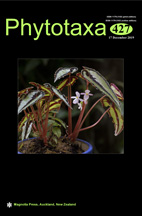Abstract
In the frame of a taxonomic revision of Hyacinthaceae subfamily Urgineoideae (Asparagaceae tribe Urgineeae) combining morphological and genetic data from numerous samples across its whole range of distribution, we here present a taxonomic revision of Geschollia, a genus originally accepted as monotypic to include G. anomala. This genus was characterized by the single, synanthous, terete leaf; long racemose inflorescence; tepals connate for ca. 1 mm and reflexed at anthesis; spreading to patent stamens; and small polygonal seeds. Our morphological studies in combination with phylogenetic analyses evidence that Geschollia is indeed a strongly supported monophyletic group, which includes eight species matching most of the features cited above. In this context, we here describe five new species in this genus and accordingly expand the original characterization of Geschollia to accommodate these new taxa. Furthermore, two new combinations are presented for previously described species. An identification key is provided for all accepted species in the genus.

